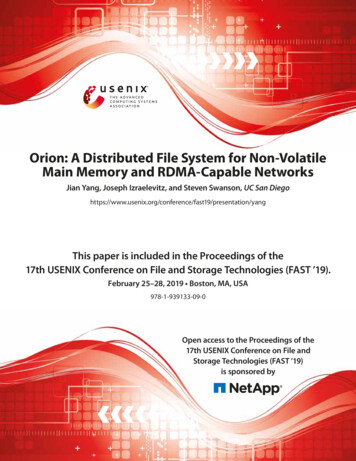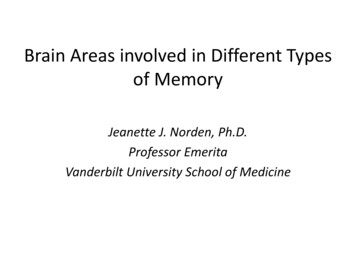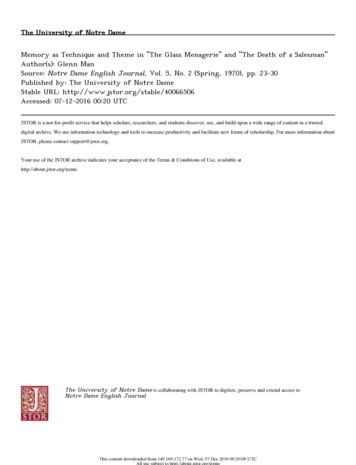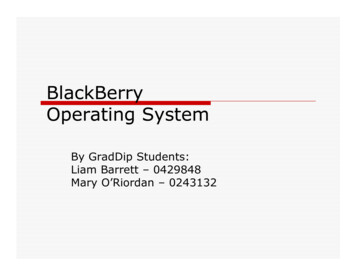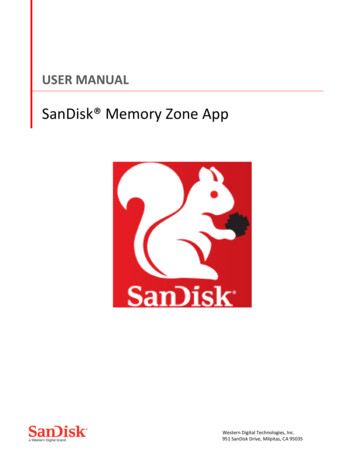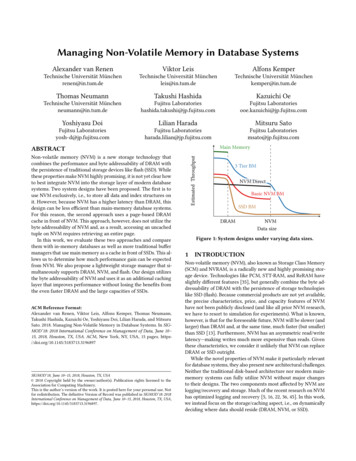
Transcription
Managing Non-Volatile Memory in Database SystemsAlexander van RenenViktor LeisAlfons KemperTechnische Universität Münchenrenen@in.tum.deTechnische Universität Münchenleis@in.tum.deTechnische Universität Münchenkemper@in.tum.deThomas NeumannTakushi HashidaKazuichi OeTechnische Universität Münchenneumann@in.tum.deFujitsu Laboratorieshashida.takushi@jp.fujitsu.comFujitsu Laboratoriesooe.kazuichi@jp.fujitsu.comYoshiyasu DoiLilian HaradaMitsuru SatoFujitsu Laboratoriesyosh-d@jp.fujitsu.comFujitsu Laboratoriesharada.lilian@jp.fujitsu.comFujitsu Laboratoriesmsato@jp.fujitsu.comMain MemoryNon-volatile memory (NVM) is a new storage technology thatcombines the performance and byte addressability of DRAM withthe persistence of traditional storage devices like flash (SSD). Whilethese properties make NVM highly promising, it is not yet clear howto best integrate NVM into the storage layer of modern databasesystems. Two system designs have been proposed. The first is touse NVM exclusively, i.e., to store all data and index structures onit. However, because NVM has a higher latency than DRAM, thisdesign can be less efficient than main-memory database systems.For this reason, the second approach uses a page-based DRAMcache in front of NVM. This approach, however, does not utilize thebyte addressability of NVM and, as a result, accessing an uncachedtuple on NVM requires retrieving an entire page.In this work, we evaluate these two approaches and comparethem with in-memory databases as well as more traditional buffermanagers that use main memory as a cache in front of SSDs. This allows us to determine how much performance gain can be expectedfrom NVM. We also propose a lightweight storage manager that simultaneously supports DRAM, NVM, and flash. Our design utilizesthe byte addressability of NVM and uses it as an additional cachinglayer that improves performance without losing the benefits fromthe even faster DRAM and the large capacities of SSDs.ACM Reference Format:Alexander van Renen, Viktor Leis, Alfons Kemper, Thomas Neumann,Takushi Hashida, Kazuichi Oe, Yoshiyasu Doi, Lilian Harada, and MitsuruSato. 2018. Managing Non-Volatile Memory in Database Systems. In SIGMOD’18: 2018 International Conference on Management of Data, June 10–15, 2018, Houston, TX, USA. ACM, New York, NY, USA, 15 pages. , June 10–15, 2018, Houston, TX, USA 2018 Copyright held by the owner/author(s). Publication rights licensed to theAssociation for Computing Machinery.This is the author’s version of the work. It is posted here for your personal use. Notfor redistribution. The definitive Version of Record was published in SIGMOD’18: 2018International Conference on Management of Data, June 10–15, 2018, Houston, TX, ted ThroughputABSTRACT3 Tier BMNVM DirectBasic NVM BMSSD BMDRAMNVMData sizeFigure 1: System designs under varying data sizes.1INTRODUCTIONNon-volatile memory (NVM), also known as Storage Class Memory(SCM) and NVRAM, is a radically new and highly promising storage device. Technologies like PCM, STT-RAM, and ReRAM haveslightly different features [35], but generally combine the byte addressability of DRAM with the persistence of storage technologieslike SSD (flash). Because commercial products are not yet available,the precise characteristics, price, and capacity features of NVMhave not been publicly disclosed (and like all prior NVM research,we have to resort to simulation for experiments). What is known,however, is that for the foreseeable future, NVM will be slower (andlarger) than DRAM and, at the same time, much faster (but smaller)than SSD [13]. Furthermore, NVM has an asymmetric read/writelatency—making writes much more expensive than reads. Giventhese characteristics, we consider it unlikely that NVM can replaceDRAM or SSD outright.While the novel properties of NVM make it particularly relevantfor database systems, they also present new architectural challenges.Neither the traditional disk-based architecture nor modern mainmemory systems can fully utilize NVM without major changesto their designs. The two components most affected by NVM arelogging/recovery and storage. Much of the recent research on NVMhas optimized logging and recovery [5, 16, 22, 36, 45]. In this work,we instead focus on the storage/caching aspect, i.e., on dynamicallydeciding where data should reside (DRAM, NVM, or SSD).
Two main approaches for integrating NVM into the storagelayer of a database system have been proposed. The first, suggestedby Arulraj et al. [4], is to use NVM as the primary storage forrelations as well as index structures and perform updates directlyon NVM. This way, the byte addressability of NVM can be fullyleveraged. A disadvantage is that this design can be slower thanmain-memory database systems, which store relations and indexesin main memory and thereby benefit from the lower latency ofDRAM. To hide the higher NVM latency, Kimura [25] proposedusing a database-managed DRAM cache in front of NVM. Similarto a disk-based buffer pool, accesses are always performed on inmemory copies of fixed-size pages. However, accessing an uncachedpage becomes more expensive than directly accessing NVM, as anentire page must be loaded even if only a single tuple is accessed.Furthermore, neither of the two approaches supports very largedata sets, as the capacity of NVM is limited compared to SSDs.In this work, we take a less disruptive approach and implementNVM as an additional caching layer. We thus follow Michael Stonebraker, who argued that NVM-DIMMs are . . .“. . . not fast enough to replace main memory and they are not cheapenough to replace disks, and they are not cheap enough to replaceflash.” [41]Figure 1 sketches the performance characteristics and capacityrestrictions of different system designs (Buffer Manager is abbreviated as BM). Besides the two NVM approaches (“Basic NVM BM”,“NVM Direct”), we also show main-memory systems (“Main Memory”), and traditional SSD buffer managers (“SSD BM”). Each ofthese designs offers a different tradeoff in terms of performanceand/or storage capacity. As indicated in the figure, all existing approaches exhibit steep performance cliffs (“SSD BM” at DRAM sizeand “Basic NVM BM” at NVM size) or even hard limitations (“MainMemory” at DRAM size, “NVM Direct” at NVM size).In this work, we propose a novel storage engine that simultaneously supports DRAM, NVM, and flash while utilizing the byteaddressability of NVM. As the “3 Tier BM” line indicates, our approach avoids performance cliffs and performs better than or closeto that of specialized systems. NVM is used as an additional layerin the storage hierarchy supplementing DRAM and SSD [7, 13].Furthermore, by supporting SSDs, it can manage very large datasets and is more economical [18] than the other approaches. Theserobust results are achieved using a combination of techniques: To leverage the byte-addressability of NVM, we cache NVMaccesses in DRAM at cache-line granularity, which allowsfor the selective loading of individual hot cache lines insteadof entire pages (which might contain mostly cold data). To more efficiently use the limited DRAM cache, our bufferpool transparently and adaptively uses small page sizes. At the same time, our design also uses large page sizes forstaging data to SSD—thus enabling very large data sets. We use lightweight buffer management techniques to reducethe overhead of in-memory accesses. Updates are performed in main memory rather than directlyon NVM, which increases endurance and hides write latency.The rest of this paper is organized as follows. We first discussexisting approaches for integrating NVM into database systems inSection 2. We then introduce some key techniques of our storageengine in Section 3 before describing how our approach supportsDRAM, NVM, and SSDs in Section 4. Section 5 evaluates our storageengine by comparing it with the other designs. Related work isdiscussed in Section 6, and we conclude the paper in Section 7.2BACKGROUND: NVM STORAGESeveral architectures for database systems optimized for NVM havebeen proposed in the literature. In this section, we revisit the twomost promising of these designs and abstract their general conceptsinto two representative system designs. They are illustrated inFigure 2 alongside the approach that we propose in this paper.2.1NVM DirectNVM, which offers latencies close to DRAM and byte addressability,can be used as the primary storage layer. A thorough investigation of different architectures for NVM Direct systems has beenconducted by Arulraj et al. [4]. Their work categorizes databasesystems into in-place update, log-structured, and copy-on-writeengines, before adapting and optimizing each one for NVM. Experimental results suggest that in most cases an in-place update engineachieves the highest performance as well as the lowest wear on theNVM hardware. Therefore, we chose this in-place update engineas a reference system for working directly on NVM (Figure 2a).One challenge of using NVM is that writes are not immediatelypersistent because NVM is behind the same CPU cache hierarchy asDRAM and changes are initially written to the volatile CPU cache. Itis only when the corresponding cache line is evicted from the CPUcache that the update becomes persistent (i.e., written to NVM).Therefore, it is not possible to prevent a cache line from beingevicted and written to NVM, and each update might be persistedat any time. It is, however, possible to force a write to NVM byflushing the corresponding cache lines. These flushes are a buildingblock for a durable and recoverable system.Logging is implemented as follows. A tuple is updated by firstwriting a write-ahead log (WAL) entry that logs the tuple id andthe changes (before and after image). Then, the log entry needsto be persisted to NVM by evicting the corresponding cache lines.Intel CPUs with support for NVM like the Crystal Ridge SoftwareEmulation Platform [14], which is also used in our evaluation, provide a special instruction for that: clwb allows one to write a cacheline back to NVM without invalidating it (like a normal clflushinstruction would). In addition, to ensure that neither the compiler,nor the out-of-order execution of the CPU reorders subsequentstores, a memory fence (sfence) has to be used. Thereafter, thelog entry is persistent and the recovery component can use it toredo or undo the changes to the actual tuple. At this point, thetransaction can update and then persist the tuple itself. After thetransaction is completed, the entire log written by the transactioncan be truncated because all changes are already persisted to NVM.As illustrated in Figure 2a, the design keeps all data in NVM.DRAM is only used for temporary data and to keep a reference tothe NVM data. The log is written to NVM as well.The NVM direct design has several advantages. By keeping thelog minimal (it contains only in-flight transactions), recovery isvery efficient. In addition, read operations are very simple becausethe system can simple read the requested tuple directly from NVM.
DRAMDRAMDRAMfull pagepage-grainedmini edSSD(a) NVM DirectSSD(b) Basic NVM BMSSD(c) Our NVM-Opt Three-Tier BMFigure 2: NVM-Based Storage Engine Designs – NVM Direct (a) stores all data on NVM, which allows for cache-line-grained accesses.Basic buffer managers (b) fixed-size pages in DRAM, but require page-grained accesses to NVM. Our design (c) uses fixed-size pages to enablesupport for SSD and, in addition, supports cache-line-grained loading for NVM-resident data to DRAM. ( hot, warm, cold cache lines)However, there are also downsides. First, due to the higher latencyof NVM compared to DRAM, it becomes more difficult to achievea very high transaction throughput. Second, working directly onNVM without a buffer wears out the limited NVM endurance, thuspotentially causing hardware failures. Third, an engine that worksdirectly on NVM is difficult to program, because there is no wayto prevent eviction and any modification is potentially persisted.Therefore, any in-place write to NVM must leave the data structurein a correct state (similar to lock-free data structures, which arenotoriously difficult).Thus, a page is never directly written back but only indirectly viathe log. The system is optimized for workloads fitting into DRAM.NVM is mostly used for durability and cold data.Our goal, in contrast, is to support workloads that also accessNVM-resident data frequently. Therefore, we extend the idea ofa buffer manager and optimize it to make NVM access cheap. Anon-optimized version is used as a baseline to represent layeredsystems.2.2Besides the storage layout, the logging and recovery components ofdatabase systems are also greatly impacted by the upcoming NVMhardware. Log entries can be written to NVM much faster thanto SSD. Therefore, from a performance perspective, it is alwaysbeneficial to replace SSD storage with NVM as the logging device.In this work, we focus on the storage layout and therefore implement the same logging approach in each evaluated system. Thismakes it possible to compare only the advantages and disadvantages of the storage engine itself with less interference of otherdatabase components.We use write ahead logging with redo and undo information. Theundo entries enable one to perform rollback and to undo the effectof loser transactions during recovery. The redo entries are usedto repeat the effects of committed transactions during recovery ifit was not yet persistent. The buffer-manager-based systems keepa log sequence number per page to identify the state of the pageduring recovery. In the NVM direct approach, this is not necessary,as changes are always immediately written to NVM. Therefore,only in-flight transactions need to be undone and every committedtransaction is durable already.Logging for NVM-based systems can be and has been optimizedin prior work [5, 36]. While each of the described storage architectures can benefit from more advanced logging techniques, webelieve that the impact on the storage engine is largely orthogonaland the two problems can be treated independently.Basic NVM Buffer ManagerGiven the downsides of the NVM direct approach, using DRAM asa cache in front of NVM may seem like a promising alternative. Awell-known technique for adaptive memory management betweena volatile and persistent layer is a buffer manager. It is used by mosttraditional disk-based database systems and can easily be extendedto use NVM instead of SSD. We illustrate this idea in Figure 2b.In buffer-managed systems, all pages are stored on the larger,persistent layer (NVM). The smaller, volatile layer (DRAM) acts as asoftware-managed cache called a buffer pool. Transactions operateonly in DRAM and use the fix and unfix functions to lock pagesinto the buffer pool while they are accessed. In the traditional buffermanager (DRAM SSD/HDD), this was necessary because it is notpossible to make modifications directly on a block-oriented device.In the case of NVM, we argue that it is still beneficial because ofthe higher latency and the limited endurance of NVM.An NVM-optimized variant of this approach has been introducedin the context of the research prototype FOEDUS [25]. The memoryis divided into fixed-size pages, and transactions only operate inDRAM. Instead of storing page identifiers, like a traditional buffermanager, FOEDUS stores two pointers. One identifies the NVMresident copy of the page, the other one (if not null) the DRAM one.When a page is not found in DRAM, it is loaded into a buffer pool.FOEDUS uses an asynchronous process to combine WAL log entriesand merge them into the NVM-resident pages to achieve durability.2.3Recovery
NVMheader 2clTokyoSan JoseRedwood CityMountain View 251 more cache linesSan FranciscoDRAMnvmpId: 3 r: 0 d: 0resident:1010.12 dirty:0010.02TokyoMunich 251 more cache linesSan FranciscoFigure 3: Cache-Line-Grained Pages – The bit masks indicatewhich cache lines are resident and which are dirty.3NVM BUFFER MANAGEMENTThe goal of our architectural blueprint is a system that performsalmost as well as a main-memory database system on smaller datasets but scales across the NVM and SSD storage hierarchy whilegracefully degrading in performance (cf. Figure 1). For this purpose, we design a novel DRAM-resident buffer manager that swapscache-line-grained data objects between DRAM and NVM—therebyoptimizing the bandwidth utilization by exploiting the byte addressability of NVM. As illustrated in Figure 2c, scaling beyond DRAMto SSD sizes led us to rely on traditional page-grained swappingbetween NVM and SSD. Between DRAM and NVM, we adaptivelydifferentiate between full-page memory allocation and mini-pageallocation to further optimize the DRAM utilization. This way, individual “hot” data objects resident on mostly “cold” pages areextracted via the cache-line-grained swapping into smaller memory frames. Only if the mini page overflows, is it transparentlypromoted to a full page—but it is still populated one cache-line at atime. We also devise a pointer swizzling scheme that optimizes thenecessary page table indirection in order to achieve nearly the sameperformance as pure main-memory systems, which obviate anyindirection but incur the memory wall problem once the databasesize exceeds DRAM capacity.3.1Cache-Line-Grained PagesCompared to flash, the low NVM latency (hundreds of nanoseconds)makes it feasible to transfer individual cache lines instead of entirepages. Using this, our so-called cache-line-grained pages are ableto extract only the hot data objects from an otherwise cold page.Thus, we preserve bandwidth and thereby increase performance.In the following, we discuss the details of this idea.A single SSD access takes hundreds of micro seconds. It is therefore important to transfer large chunks (e.g., 16 kB) at a time inorder to amortize the high latency. Therefore, a traditional buffermanager has to work in a page-grained fashion: When a transaction fixes a page, the entire page is loaded into DRAM and the datastored on it can be processed. Our buffer manager, in contrast, initially only allocates a page in DRAM without fully loading it fromNVM. Upon a transaction’s request for a certain memory region,the buffer manager retrieves the corresponding cache lines of thepage (if not already loaded).The page layout is illustrated in Figure 3. The cache-line-grainedpages maintain a bit mask (labeled resident) to track which cachelines are already loaded. In the example, the first, third, and lastcache line is loaded, as indicated by a bit set to 1 at the correspondingposition in the bit mask. Similar to the resident bit mask, the dirtybit mask is used to track and write back dirty cache lines. The rand d bits indicate whether the entire page is resident and dirty,respectively. To allow for the loading of cache lines on demand,pages additionally store a pointer (nvm) to the underlying NVMpage. With 16 kB pages, there are 256 cache lines and therefore thetwo bit masks require 32 byte each. Together with the remainingfields ( nvm pId r d (8 8 1 1) byte 18 byte), theentire header ((2 32 18)byte 82 byte) fits into 2 cache lines(128 byte) and thus incurs only a negligible space overhead of lessthan 0.8 %.While this cache-line-grained design includes an extra branch onevery access (to check the bit mask), it often reduces the amount ofmemory loaded from NVM into DRAM drastically: As an example,consider the leaf of a B-tree [6] where pairs of keys and values arestored in sorted order. Assuming a page size of 16 kB and a key and value size of 8 byte each, there are at most 16 kB 8 byte 8 byte 1024 entries on a single page. A lookup operation only requiresa binary search, which uses loд2 (1024) 10 cache lines at most.Therefore, our design only needs to access 64 byte 10 640 byte,instead of 16 kB. While this is already a huge difference, it can beeven greater. In the case of the YCSB and TPC-C benchmarks, whichwe use in our evaluation (Section 5), we measured an average of6.5 accessed cache lines per lookup.A system allowing for cache-line-grained accesses is more difficult to program than a conventional page-based approach. Thereason for this is that all data needs to be made resident explicitlybefore accessing it and marked dirty after modifying it. But workingwith a cache-line-granularity is optional and it is also possible toload and write back entire pages. Therefore, we only implement theoperations, that provide the most benefit, in a cache-line-grainedfashion: like lookup, insert, and delete. Other infrequent or complicated operations (like restructuring the B-tree) are implemented byloading and processing the full page (avoiding the residency checks).The overhead of checking the residency of every single cache lineonly pays off if we access a small number of cache lines. During scanoperations or the traversal of inner nodes in a B-tree, many cachelines are accessed and cache-line-grained loading should thereforenot be used.3.2Mini PagesCache-line-grained pages reduce the consumed bandwidth to a minimum by only loading those cache lines that are actually needed.However, the page layout described previously still consumes muchmore DRAM than necessary. In this section, we introduce a second,smaller page type called mini page, which reduces the wasted memory. Consider the B-tree leaf example from above: Merely 640 byteout of 16 kB are accessed, but the system still allocates the 16 kB (excluding the header) in DRAM for the page. This problem is knownfrom traditional disk-based systems: An entire page is loaded andstored in DRAM even if only a single tuple is required, wastingvaluable NVM bandwidth and DRAM capacity. In the following, wewill use the term full page to refer to a traditional page, as it was introduced before. Note that both pages (mini and full) are able to use
NVMheader 1clTokyoSan JoseRedwood CityMountain View 251 more cache linesSan FranciscoDRAM root 6nvmslots: [0, 2, 255] pId: 3count: 3 dirty: 0100.02fullTokyoMunichSan Franciscoparoff: 0pId: 6cnt: 1ptrpId: 5 . . . pId: 85 swizzled leaf paroff: 12pId: 7 cnt: 0.7 11 more cache linesFigure 4: Mini Pages – The slots array indicates which cachelines are loaded (max 16). If promoted, full points to the full page.cache-line-grained loading to optimize bandwidth utilization—butnot DRAM utilization. Hence, the term cache-line-grained page canrefer either to a mini page or a full page.The implementation of mini pages is illustrated in Figure 4. Itconsumes only 1088 byte of memory and is able to store up to 16cache lines. The slots array implements the indirection. It storesthe physical cache line id for each of the 16 cache line slots. Forexample, the cache line with the content “San Francisco” is located atthe physical index 255 on the page but loaded into slot 2 on the minipage. Therefore, the slots array stores the index 255 at position 2.The array only requires 16 byte because each physical cache line idfits into one byte. In total, the mini page header fits into a singlecache line: nvm slots pId count dirty full (8 16 8 1 2 8) byte 43 byte. This is a very low overhead(0.3 %) when compared to the size of a full page, which would beused in a system without mini pages. The count field indicateshow many cache lines are loaded, e.g., a value of three means thatthe first three cache line slots of the mini page are occupied. Theadditional dirty bit mask indicates which cache lines must bewritten back to NVM when the page is evicted. In our example, thecache line “Redwood City” changed to “Munich” and needs to bewritten back.Accessing memory on a mini page is more complicated than ona full page. Due to the mapping of cache lines, data members on thepage can-not be directly accessed. Therefore, we use an abstractinterface that enables transparent page access:void M a k e R e s i d e n t ( Page p , i n t o f f s e t , i n t n )The function takes a page p as an input and returns a pointerto the memory at the specified offset with a length of n bytes.In case p is a full page, the specified cache lines are loaded (ifnot yet resident) and a pointer to it is returned. Otherwise, incase of a mini page, the function searches the slots array forthe requested cache lines. If these are not yet resident, they areloaded and added to the slots array. Afterwards, a pointer to theoffset in the (now) resident cache line is returned. Thus, this basicinterface transparently resolves the indirection within the minipages. Compared to a traditional page, the only difference is thatmemory on mini pages can no longer be accessed directly but onlyvia this function.Mini pages need to guarantee that the memory returned by thesefunctions is always contiguous, i.e., if more than one cache line isrequested (e.g., cache lines with id 3 and 4), they need to be storedDRAMNVM. normal leaf paroff: 0pId: 5 cnt: 0. swapped out leaf pId: 5pId: 6pId: 7pId: 8.Figure 5: Pointer Swizzling – A B-tree with a root (pId: 6) andthree child pages: A swizzled page (pId: 7), a normal DRAM page(pId: 5) and a page currently not in DRAM (pId: 8).consecutively (i.e., 4 needs to be stored directly after 3) in the minipage’s data array. Otherwise, the returned pointer would only bevalid for the first cache line. To guarantee this, our implementationmaintains the cache lines in sorted order (w.r.t. their memory locations). The overhead of maintaining order is small because, thereare at most 16 elements and it is not on the critical path (only afterloading from NVM). The benefit of this approach is that it simplifiesimplementation, as it avoids complicated reordering logic.When a mini page does not have enough memory left to servea request, it is promoted to a full page. To do this, an empty fullpage is allocated from the buffer manager and stored in the minipage’s full member. Next, the current state of the mini page iscopied into the newly allocated full page: all resident cache lines,the residency and dirty information. If the example mini page inFigure 4 was promoted, the newly initialized full page would looklike the one in Figure 3. Finally, the page mapping table in the buffermanager is updated to point to the full page. From now on, the minipage is called partially promoted and all requests to the mini pageare forwarded to the full page. It is only safely garbage collected,once the last transaction unfixes it. This is guaranteed to happen,as the page mapping table points to the full page and thereforeno new references to the mini page are created. This feature isconvenient for the data structures using mini page because this wayits reference to the mini page is not invalidated when a promotionhappens. Thus, a promotion is hidden from data structures anddoes not incur additional complexity.3.3Pointer SwizzlingWhile the buffer pool, allows the system to benefit from the lowlatency DRAM cache, it also introduces a non-neglectable overhead.In this section, we introduce pointer swizzling, a technique thatreduces this overhead (mainly the page table lookup) by dynamically replacing page ids with physical pointers. In a traditionalbuffer manager (DRAM SSD/HDD), this overhead is only noticeable if most of the working set fits into DRAM. Otherwise, thepage has to be loaded from SSD/HDD anyway, which is orders ofmagnitude slower compared to the hash table lookup. In contrast totraditional buffer managers, in our proposed system, this overheadis also relevant for larger workloads. We cannot hide the overhead
behind even slower loads because (a) these loads are not that muchslower (NVM latency is a lot lower than that of flash) and (b) theamount of data read is much less due to the cache-line-grainedloading. Therefore, it is important for our system to minimize thesemanagement overheads as much as possible.Pointer swizzling has recently been proposed in the context oftraditional buffer managers (DRAM SSD/HDD) [17]. The idea isto encode the address of the page directly in the page identifier forDRAM-resident pages. The most significant bit of the page identifierdetermines whether the remaining bits constitute a page identifieror a pointer. Thus, when accessing a page, the system first checkswhether the most significant bit is set. If so, the remaining bitsencode a pointer that can be dereferenced directly. Otherwise, theremaining bits are a page identifier and the system has to check thehash table in the buffer manager to find the page or load it fromNVM if not present. This way, the hash table lookup is avoided forDRAM-resident pages and thereby the overhead is reduced to asingle branch.Figure 5 illustrates our implementation of pointer swizzling.On the left-hand side, the buffer manager’s page mapping tableis shown. It maps page identifiers (numbers in the table) to pages(represented by arrows). The example shows a B-tree with one rootnode (pId 6) and three leaf nodes: The first one (pId 7) is a swizzledleaf. The root can use a pointer (blue arrow) to access it instead ofthe page id. The second one (pId 5) is a normal leaf (not swizzled)and the third one (pId 8) is a swapped out leaf—currently notlocated in DRAM.In the example, the root page has one swizzled child (as indicated by the cnt) field. A page with swizzled children can never beswapped out because the pointer to the swizzled child would be persisted. When a swizzled page (the left child with page identifier 7 inthe example) is swapped out, it needs to update its parent (locatedvia the par pointer): First, it decreases the child count, which islocated at a fixed offset. Second, it converts the pointer pointing toitself back into a normal page identifier. The location of this pointercan be found using the offset field (off). The parent pointer (8 by
main-memory database systems, which store relations and indexes in main memory and thereby benefit from the lower latency of DRAM. To hide the higher NVM latency, Kimura [25] proposed using a database-managed DRAM cache in front of NVM. Similar to a disk-based buffer pool, accesses are always performed on in-memory copies of fixed-size pages.
